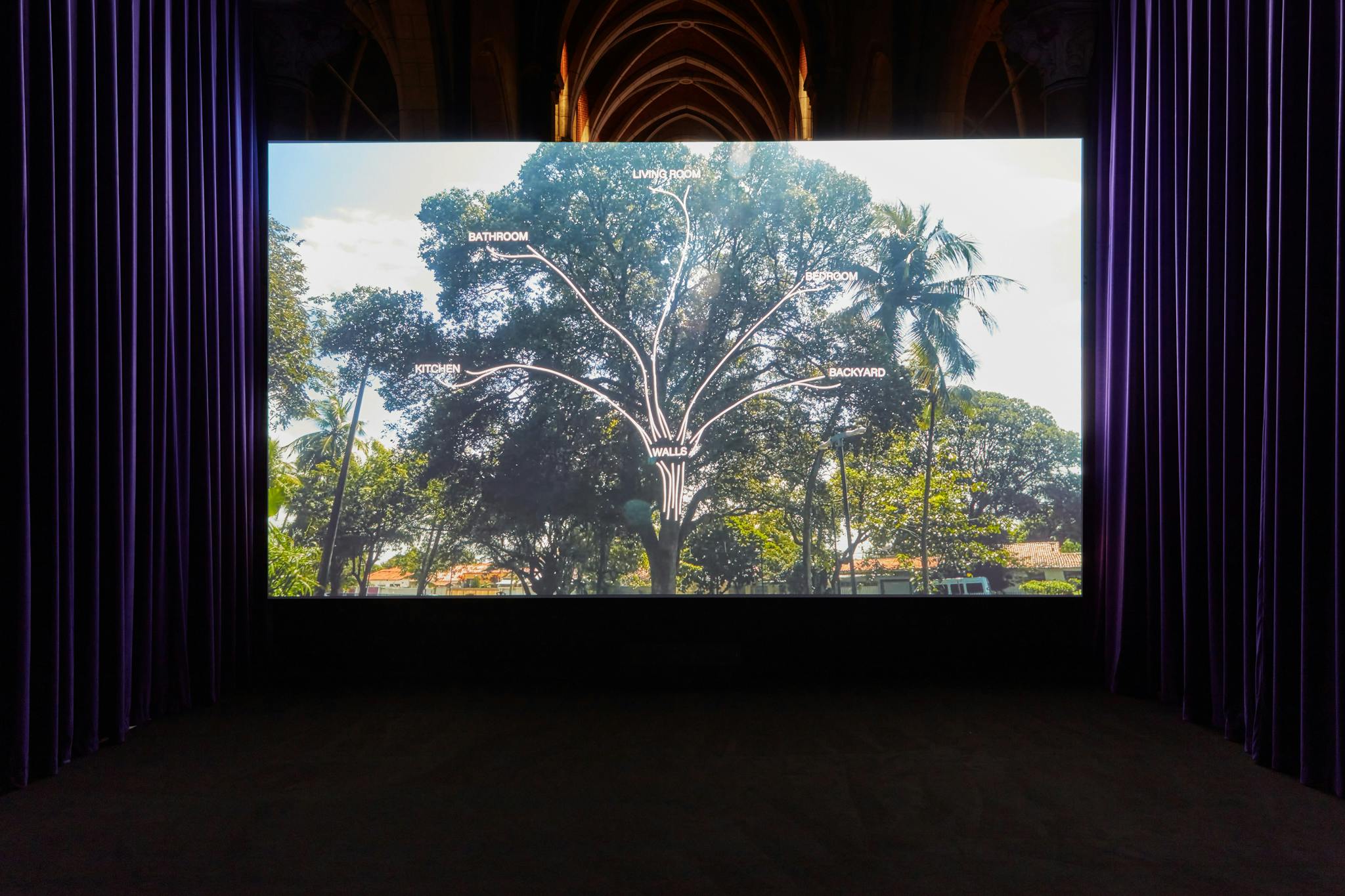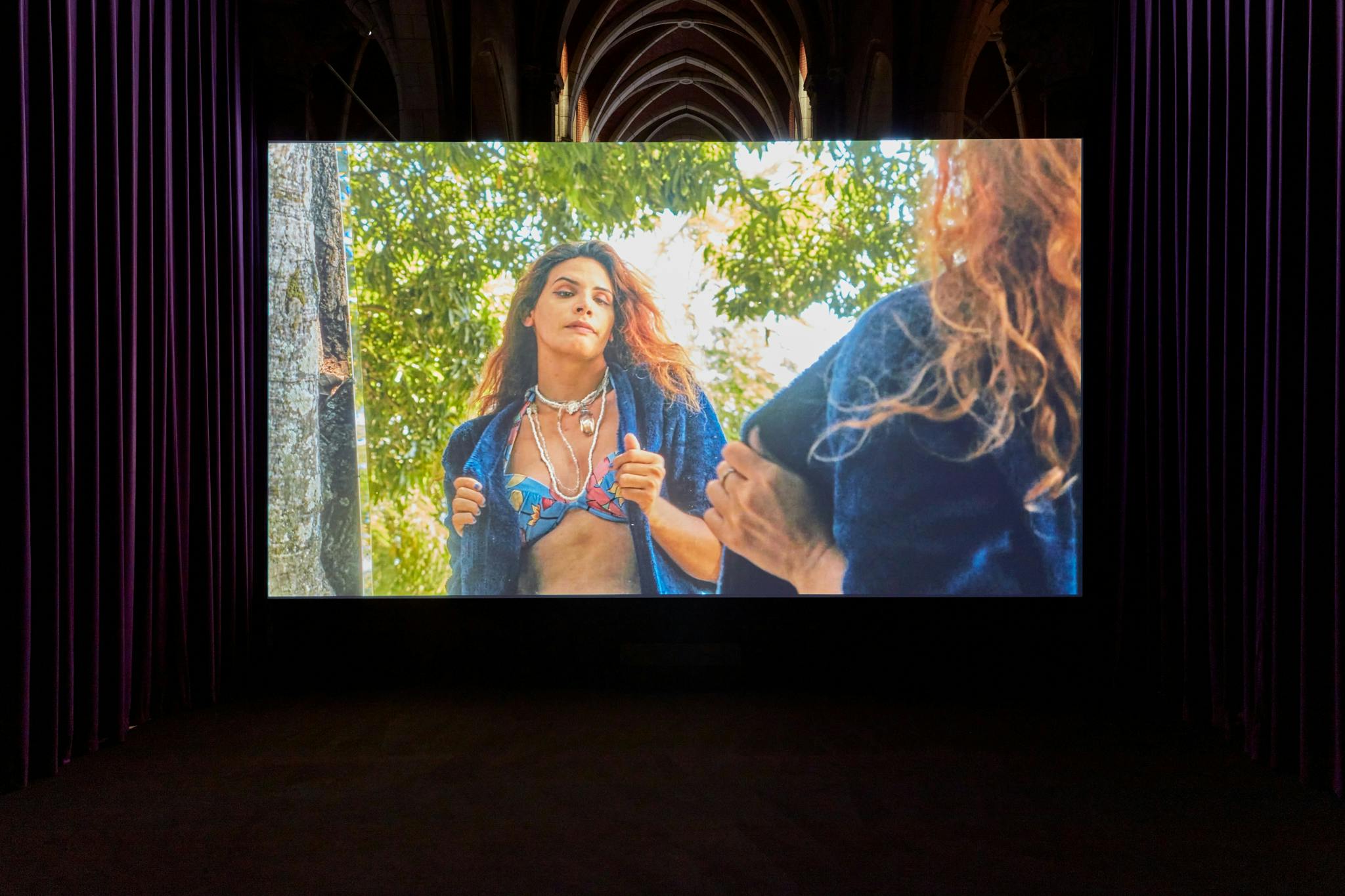I meet Jonathas de Andrade (1982, Maceió, Brazil) in the courtyard of Kunsthal Extra City. The artist won’t be in Antwerp for more than 24 hours, as a stopover between Venice – where he is representing his homeland at the Biennale – and Paris, where a solo show of his is currently running at Galleria Continua. During Art Basel, his first survey exhibition in Europe opened at CRAC Alsace, in Altkirch (FR), curated by João Mourão and Luís Silva. Joining us at the table are artist Elen Braga and curator Joachim Naudts, who invited Jonathas de Andrade to kick off his program Revolting Times in Extra City, for which four international artists will each show a video work for about a month. Olho da Rua is the result of an intensive collaboration with a community of homeless people in de Andrade's hometown of Recife, in the north-east of Brazil.

Jonathas de Andrade: With Bolsonaro, Brazil came back on the hunger map. In the streets of Recife the homeless population had increased brutally. I always wanted to approach a group of people living in the streets but it is very delicate on an ethical level. At the same time, there was a sense of urgency in the air so I proposed to do a film with them. I worked with public shelters and social assistants from NGOs to mediate the discussions. They invited the people to participate, and I started photographing the possible participants as a casting process. In doing so, they got used to my presence and started to imagine how they would be in the film. I also started listening to their expectations.
Pieter Vermeulen: Did you have a rough scenario in mind?
JdA: I had some propositions, but we only had two days for the shooting. We had to decide how many and who to include, so I proposed to gather one hundred people who were interested to be part of this filming and theatrical experience. The public square where we were filming is a very residential area, with a positive, lovely atmosphere. Initially I wanted to organize a banquet or a feast but then I felt it could be inappropriate because some of them were actually experiencing hunger. After a few meetings, everything was complexified, they said hunger was not really an issue, it was more about the quality of the food. So, I realized the issue was way more complex and started amplifying the focus. It was still about the mouth, about speaking, about what you put inside the body, about what the body screams out. But I understood it would equally be about the gaze, about the way we look at those people and the way these people are invisible in the daily life of the city.

There were many challenges related to production. Working with non-actors made me feel I couldn’t overdirect, but [had to] work with the flow in the filming set and how they would engage or transform my initial propositions. Some would poke and challenge me. I was also ethically in constant alert, asking myself if I was at all entitled to speak about these issues. I was very careful not to be paralyzed by these doubts, I had to act. It was very strong emotionally. Afterwards, in the studio, the material looked so chaotic and completely different from what I imagined. Now, looking back, there was no way I could control everything according to my script. From the very beginning, it was clear that I couldn’t force a clear path, but work within what was being staged, developed and enacted, sometimes more fictionally, some other more documentarily, spontaneously. So, I proposed a couple of scenes that were open-ended. For instance, at the beginning of the film is a scene where I asked them to just look in the mirror.

In the end, the film is about acts of looking. They are looking at themselves, them looking at us, we are looking at them and they are staging themselves to us. It was a conscious decision to remove or pick all the images that were undignified for them. As the camera gets closer to someone, there is a brightness that clearly shows up. That’s what I wanted to show, that people are beautiful. This has an effect for them when seeing the film after, and it’s absolutely inspiring and contagious for the audience, as a poignant message from Brazil, directly from the streets.
PV: What motivated you in working with these people? What is it you wanted to show?
JdA: In Brazil, human rights are being violated, indigenous lands are being taken, there is illegal mining and even assassinations of activists and community leaders. There is an apparent genocide going on against black and indigenous communities. I mean, the landscape is horrendous. One third of the population still supports Bolsonaro. With Lula (Brazilian president between 2003 and 2010, pv) there had been a manoeuvre of repositioning his figure, in such a way that a conservative portion of the elites supported the idea that Lula was someone to be hunted. The past years have been so sad and depressing that everything got stuck.

For me, the film was a great pretext to engage with the whole complexity of it while simultaneously challenging my own position as an artist, making my own contradictions and privileges more explicit. The whole discussion about legitimacy, how to speak about the reality of others that we are not a part of, is very important. I shared previous edits to friends and collaborators. We are all learning how to be more responsible and ethical when working collaboratively, and working with images of other people, especially in vulnerability. I think it’s challenging but absolutely necessary to depict and discuss those that are made invisible in the eyes of the law, of the rights, of the city.
That is why it was important for me to also show the film to the people I collaborated with, before showing it in Venice. The title Olho da Rua (translated as ‘Out Loud’, pv) is a strong expression in Brazil used when someone is dismissed or fired from the job. Having this title also speaks about the strength of looking, and having lessons that remind us that new ways of looking are necessary.

PV: I have the strong impression that it is dealing with different notions of spectatorship.
JdA: I have been inspired by the theories of Brazilian playwright Augusto Boal about the Theatre of the Oppressed. I’m not a specialist but I came across his writings while working on previous projects like Jogos dirigidos (Directed games, 2019), that portrays a community of deaf people that invented their own language in the dry countryside of Varzea Queimada, in the Piauí state of Brazil. I realized that the dynamics that I was trying to establish with this group of participants resonated with his ideas about a group of a certain social or political background invited to perform about themselves or their realities. In this way, they have a chance to rearticulate their narratives or be more aware of their own condition. It’s about playing on the borderline of fiction and non-fiction, something which I really enjoy. Stepping a little outside of your own life and playing someone or something is interesting. This dramatization has a certain didactic strength to the community. I really believe in the possibility of debate and the capability of creating emotion as a catalyst for understanding.

PV: You are also showing Olho da Rua in the exhibition Penumbra in Venice, organized by the Fondazione In Between Art Film that also commissioned the film. In addition, and perhaps more importantly, you are representing Brazil at the Biennale this year. How do you deal with this nationalist agenda or stamp that is put on you?
JdA: Representing Brazil was both a challenge and an honour. A challenge, because it’s hard to imagine a representation of Brazil today as a single one, as a single point of view. Any attempt to represent a collectivity would result in a failure. Especially in a multi-ethnical, complex Brazil facing the political scenario we have now, where the current president isn’t representing the country at all. We have an election coming up in October. So, for me, it was very important in the pavilion to bring the energy up instead of being totally melancholic. The reality of the news is raw and depressing already. Instead, my idea was to represent the power of collectivity through language, precisely because language depends on daily reaffirmations – such as metaphors – applied to everyday issues, political and social but also related to passion. I wanted to spread the message that, as a collective, we can rearrange and reinvent the narratives of the present, and that is absolutely urgent.

PV: Sounds like a difficult balancing act.
JdA: Yes, pretty much. The Brazilian pavilion is an official building of the government so I had to be diplomatic. In the project for the pavilion, the body is chopped into pieces and I use different metaphors that are politically charged. I like the example of ‘eu vou bater o pé’, which means ‘I’m putting my foot down’, as in ‘I’m not leaving this land’. And then there is an example about passion: ‘with the heart coming out of the mouth’ (‘Com o coração saindo pela boca’, also the title of the exhibition, pv). For me, these contrasts are really beautiful. The same body that suffers is the same body that can take a breath again.
PV: The act of breathing was also evoked by an inflating and deflating sculpture in the pavilion.
JdA: Exactly. This was for me connected to the idea that Brazil was expelling us, with a pavilion that is discreetly and symbolically pushing visitors out. That is exactly how the sculpture functioned for me; first we think it is beautiful, until we have no more space left. On a symbolic level, it was a good challenge for me as an artist to play with fantasy and metaphorical language. Just like a schoolish presentation, visitors are entering a body that is completely chopped up but that also represents a social and political body which speaks of an urgent historical present.